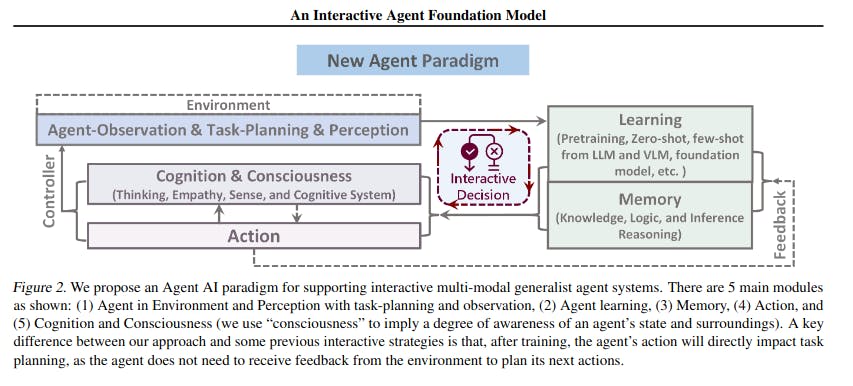Table of contents

As Geoffrey Hinton, a leading figure in Deep Learning, had already claimed, "Digital Intelligence may surpass Biological Intelligence." This statement sparks fear and curiosity: Are we on the brink of being replaced by AI? The questions are echoing through every corner of our minds. The paper presents Microsoft's new AI model called the Interactive Agent Foundation Model, which helps AI agents think and act more like humans across different tasks. By Training them in various skills simultaneously, it's a big step towards making AI smarter and more adaptable in real-world situations.
In a world where the boundaries between human intelligence and artificial intelligence continue to blur, OpenAI's latest creation, SORA, emerges as a beacon of innovation, promising to revolutionize the way we interact with AI systems. But first, we have to understand the new trend. In a paradigm shift within the realm of artificial intelligence (AI), Microsoft has introduced a transformative innovation—the Interactive Agent Foundation Model. This groundbreaking model represents a departure from static, task-specific AI systems towards dynamic, agent-based frameworks capable of excelling across a diverse array of applications.
Abstract
Microsoft's Interactive Agent Foundation Model pioneers a novel approach to AI development, leveraging a multi-task agent training paradigm to empower AI agents across a broad spectrum of domains. By integrating strategies such as visually masked autoencoders, language modeling, and next-action prediction, this model emerges as a versatile and adaptable framework for AI applications. Through rigorous experimentation across robotics, gaming AI, and healthcare domains, the model showcases its ability to generate meaningful and contextually relevant outputs, promising a new era of AI capabilities.
Results
The experiments conducted to evaluate the Interactive Agent Foundation Model provide compelling insights into its efficacy and versatility. Through pre-training experiments encompassing diverse datasets such as Language Table, CALVIN, Minecraft, and Bleeding Edge, the model demonstrates robust performance across various tasks. Notably, in robotics experiments, the model exhibits superior performance compared to existing methodologies, showcasing its ability to handle complex manipulation tasks with precision. Gaming experiments reveal the model's proficiency in predicting actions and reconstructing scenes, underscoring its adaptability across virtual environments. Healthcare experiments further validate the model's utility, showing promising results in video captioning, visual question answering, and activity recognition tasks.
Conclusion
Microsoft's Interactive Agent Foundation Model heralds a new frontier in AI research, offering a pathway towards the development of generalist, action-taking AI systems. With its ability to understand diverse input modalities and produce coherent outputs across interactive environments, this model represents a significant advancement in AI technology. As we continue to explore the potential applications of this model across various domains, we stand on the brink of a transformative era in AI-driven solutions.
In Figure 2, one can easily understand and get an idea of how these new interactive agents are going to behave & we can induce the following results from this.

| Aspect | Description |
| Introduction of Interactive Agent Foundation Model | Microsoft introduces the Interactive Agent Foundation Model, aiming to imbue AI with human-like traits and adaptability. |
| Potential for Artificial General Intelligence (AGI) | The model explores key skills such as decision-making, perception, memory, and communication, signaling progress towards achieving AGI. |
| Versatility Across Domains | Designed to operate across diverse fields including healthcare, gaming, and robotics, showcasing adaptability and real-world potential. |
| Training Paradigm | Utilizes a novel training approach enabling AI agents to learn from multiple tasks and datasets concurrently, enhancing their flexibility. |
| Application in Healthcare and Robotics | Shows promise in healthcare diagnostics, caregiving assistance, gameplay strategy, and physical actions within robotic environments. |
| Scalability and Efficiency | Capable of efficiently handling a variety of tasks with a single model, facilitating widespread adoption and scalability. |
| Transition to Real-World Applications | Represents a shift from theoretical AI research to practical implementation across industries, bridging the gap between theory and practice. |
| Ongoing Development | Ongoing advancements from Microsoft, OpenAI, and other entities indicate a continuous evolution in AI technology, promising further breakthroughs. |
| Excitement for Future Innovations | The blog concludes with anticipation for future announcements and the transformative potential of AI technology in shaping our world. |
Impact Statement
While the Interactive Agent Foundation Model holds great promise for revolutionizing industries such as gaming, robotics, and healthcare, it is crucial to acknowledge and address potential societal implications. While the model's deployment in robotics offers exciting possibilities, caution must be exercised to ensure safety and ethical considerations are prioritized. In gaming, while the model enhances player experience, measures should be taken to mitigate potential risks such as addiction. In healthcare, the model's role as an aid to caretakers underscores the importance of maintaining human oversight to ensure patient safety. As we navigate the evolving landscape of AI, responsible deployment and continuous monitoring of AI models remain paramount.
With Microsoft's Interactive Agent Foundation Model paving the way for a future where AI systems are more adaptive, versatile, and impactful, we find ourselves on the cusp of a transformative era in technology—one filled with boundless possibilities and unprecedented opportunities for innovation. And we just have to follow the trends and keep ourselves in the learning phase forever in this ever-changing world.
References:
[1] Microsoft Research Paper: "Interactive Agent Foundation Model" (https://arxiv.org/pdf/2402.05929.pdf)
Sincerely,
Muhammad W.

